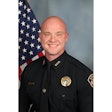 Editor David GriffithPhoto: Kelly Bracken
Editor David GriffithPhoto: Kelly Bracken
It's not hard to find information on the number of law enforcement officers who are killed in the line of duty. Each year the National Law Enforcement Officers Memorial Fund (NLEOMF) sends out a press release that announces the number. In 2018, the number was 145, and of that number 53 died by gunfire.
The NLEOMF number for LODDs is unofficial, but it's usually pretty accurate. You'll have a much tougher time coming up with any accurate statistics for the number of officers wounded in 2018.
A year or so from now the only official report on the officers who were killed and wounded in 2018 will be made public when the FBI releases its annual LEOKA. The LEOKA (law enforcement officers killed and assaulted) report is the only official accounting of violence against your profession and even the people who produce it will tell you that it woefully under counts the "assaulted" side of the ledger. That's no slam on the folks who produce LEOKA; they are at the mercy of the data they have available. It's easy to count the dead because agencies have to file all kinds of reports about duty deaths, but the statistical picture gets a lot muddier when we discuss the wounded.
Often wounds are not reported even by the people who experienced them. I have two veterans in my immediate family, one from World War II (now deceased) and one from the Vietnam War. Both received what they considered minor wounds in combat; neither one reported their wounds.
Counting the wounded in police operations is difficult. But I think it's very important that we start to do a better job of it. People tend to think that all the violence that occurs against police officers can be counted in the death total. That totally discounts the sacrifice of those men and women who were wounded in the line of duty. And I believe their ranks are growing at an alarming rate.
January was a bloody month for American law enforcement. By my unofficial count of articles on PoliceMag.com, four officers were feloniously killed last month. Using the same methodology, I count 12 law enforcement officers wounded in the same period.
Many accounts of attacks against officers end with the line that the officer suffered non-life-threatening wounds. That's a very vague term. You can be severely wounded and not suffer injuries that would threaten your life if you receive timely and appropriate medical care.
The murkiness of the term comes from the wide spectrum of possible wounds. You can be shot and receive a grazing wound that the reporters discount despite the fact that none of them would volunteer for the experience. Or you can be shot and be paralyzed, or brain damaged, or have internal organ damage. And even one of those non-life threatening gunshot or stab wounds can result in a lifetime of chronic pain.
The truth is that it can be difficult to kill someone with a handgun or knife in 2019. Emergency medicine is really effective these days, even when someone is shot in the head. And because of that emergency medical care many an officer has survived critical wounds.
Many of these grievously wounded officers have exhibited great courage and determination in trying to rebuild their lives. Consider the case of Arnold, MO, police officer Ryan O' Connor. In December 2017, Officer O'Connor was transporting a burglary suspect when the man somehow managed to gain access to a pistol and shot the officer in the back of the head. Officer O'Connor was not expected to survive that terrible wound. But he did. And with the support of his wife, his family, his friends, and the national law enforcement community, he is working every day to rebuild the life that was nearly taken from him.
Officers like Ryan O'Connor are why we need a better accounting of the men and women in law enforcement who are wounded on duty. The statistics on the fallen are not enough to provide the public with a portrait of the real sacrifice of the men and women who wear the badge. Reporters and columnists use this incomplete portrait to point out that there are much more dangerous professions. Worse, they tend to discount the malicious nature of the damage inflicted on officers by referring to men and women who were intentionally wounded as "injured."
Each May we hold a ceremony to honor law enforcement officers killed in the line of duty. Maybe it's time we also held a ceremony to honor those wounded on duty.


















